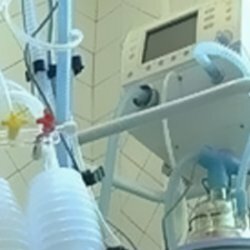Adiposo-genital degeneration

Species
In children, the picture of obesity most often manifests itself at the age of 10 to 15 years, less often it starts from 6-8 years. This fact alone shows that the sex glands are undoubtedly important in the development of the obesity syndrome. Depending on the prevalence of impaired activity of the pituitary gland or the sex glands, it is possible to distinguish primarily the neuropsychiatric type of obesity and predominantly the genital type of obesity.
Symptoms of
The most characteristic sign of this syndrome is a pronounced obesity with the accumulation of fat masses in the shoulder region, in the lumbar, pelvic and femoral region and especially in the abdomen and buttocks. These accumulations of fat account for the high weight of these children. The growth of obese children either remains normal, or even below the norm in cases of the pituitary type and, conversely, above the norm in cases of the genital type. The circumference of the chest also gives high figures. According to Martin's anthropometric profile( indicators of growth, mass and circumference of the chest and head circumference, drawn as a curve of the curve with deviations within the sigma in one direction or the other), two types of obesity can be distinguished, since in the genital type of obesity, the relatively high growth is characteristicAnd long-legged. The Pelidisi index( the private root of the square third degree from the product of the coefficient 10 and the body weight by the growth of sitting, multiplied by 100) gives exceptionally high figures - up to 110;The Brunch index( the quotient from dividing the product of the circumference of the chest in centimeters and the coefficient of 100 per body length in centimeters) is also increased( from 54 to 65);The index of the Beduzi( the quotient of dividing the difference in body length( standing growth) and the growth of sitting on the growth of sitting, multiplied by 100) or normal, or elevated( 78-84);The Pignier index( growth in centimeters minus weight in kilograms minus the circumference of the chest in centimeters) often descends to negative values. Secondary sex indicators are inadequately expressed. Scoliosis, kyphosis, curvature of the legs are often noted.
The psyche is developed normally;Children usually attend a normal school and study well. However, in some cases, we can note some features of infantilism. Attention is weak, unstable, the ability to memorize is lowered, thinking is often marked by resonance, the mood is often upbeat, euphoric and yet labile.
Occasionally, headaches occur, epileptiform attacks in those cases when symptoms of neoplasm in the brain and visual acuity decrease are expressed.
It is characteristic of a sharp decrease in metabolism, in particular, a decrease in the specific-mobile action of proteins. There is also a fairly high tolerance to carbohydrates. In the differential-diagnostic relation, we must distinguish obesity of the hypothyroid and cerebral type.
Rare variations of
It is quite natural to assume the possibility of obesity formation on the basis of the disturbance of the functions of only the interstitial brain. Biddle described a special type of obesity, characterized by the fact that along with the metabolic disorder, polydactyly, retinal pigmentation and brain psychiatric disorders were identified. Sometimes there is another variant, in which development is observed, but without intellectual disturbance, with simultaneous atrophy of the genital organs, weakening of the response from blood pressure and glycemia after the administration of suprugenin. Finally, pigmentation is very characteristic with hundreds of small birthmarks scattered, as in recklinghausen's disease( systemic hereditary disease affecting the nervous system and skin, otherwise called type I neurofibromatosis), like stains from coffee and milk. Sometimes there is congenital atrophy of the optic nerve, amovroz. Concentric narrowing of the field of view. This form of obesity occurs in children with pathological neuro-arthritic heredity. Usually obesity is revealed from the first year of life, it is kept very stubbornly, it does not depend on the food regime. Obesity evenly extends to the entire body and head, and can reach excessive degrees. Growth usually occurs either within normal limits, or slightly above normal. Characteristic is the presence of some signs of mental retardation.
Treatment of
If it is finally established that the cause of the disease is a tumor, then, as far as possible, operative treatment or radiation therapy is indicated, in case the tumor is not operable. Treatment of obesity should be combined, composed, on the one hand, from regulating the diet, and on the other hand - from the supply of hormones to the body. First of all, the consumption of fats and carbohydrates should be limited with some limitation of the amount of liquid. The protein component of food can be left untouched. If there is bulimia( a pathologically increased appetite), then anorexigenic agents are indicated. It is recommended increased physical activity. It is quite rational to treat mineral waters, in particular - Borjom. In more severe cases, as well as in neglected cases, treatment with hormones is necessary. The most rational would be the use of pituitary drugs( pituitary, pituitary), but practice shows that they rarely give a favorable effect. Thyroidin is more effective. Thyroidine is given in ascending doses from 0.05 to 0.2 2-3 times a day under the control of the weight curve and cardiac activity. Quite rational is the combination of thyroidin with ovaryin( 5-10 drops each).The boys are shown preparations of testicular hormones in the form of orchicrin and testicular fluid.



